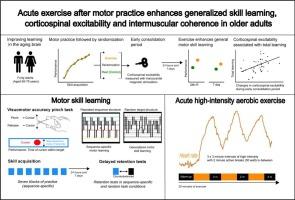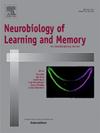Acute exercise after motor practice enhances generalized skill learning, corticospinal excitability and intermuscular coherence in older adults
IF 1.8
4区 心理学
Q3 BEHAVIORAL SCIENCES
引用次数: 0
Abstract
While high-intensity aerobic exercise after motor practice enhances learning in young adults, its effects on older adults remain unknown. This study investigates whether high-intensity exercise after motor skill practice enhances memory consolidation and motor learning in older adults (aged 65–75 years). Participants practiced a visuomotor-pinch-task with repeated sequence-structure, before being randomly assigned to an exercise (EXE, n = 20) or control (CON, n = 20) group. Motor performance was assessed at baseline, immediately after practice, and in delayed retention tests performed 24-hours and 7-days later. Performance was also assessed in a task variant with random target-structure at immediate and delayed retention. Electromyography was recorded from first dorsal interosseous and abductor pollicis brevis muscles, for intermuscular coherence analysis. Corticospinal and cortical excitability was assessed by single and paired-pulse transcranial magnetic stimulation of the primary motor cortex at baseline, after practice, and again after the EXE or CON intervention. No between-group differences were observed during skill acquisition (before randomization). From immediate to delayed retention tests (24-hours and 7-days) EXE showed higher retention in the random target-structure variant compared to CON, while no differences were observed in the sequential task. Both groups demonstrated increased corticospinal excitability after practice. EXE led to prolonged increases in intermuscular coherence and corticospinal excitability compared to CON, and changes in corticospinal excitability were associated with total learning effects from baseline to day7. These results demonstrate that acute exercise prolongs practice-dependent increases in corticospinal excitability during early memory consolidation. The study provides insights into the potential of exercise to enhance motor learning and neuroplasticity in older adults.

运动练习后的急性运动增强了老年人的广义技能学习、皮质脊髓兴奋性和肌间一致性。
虽然运动训练后的高强度有氧运动能提高年轻人的学习能力,但它对老年人的影响尚不清楚。这项研究调查了运动技能练习后的高强度运动是否能增强老年人(65-75 岁)的记忆巩固和运动学习。在被随机分配到锻炼组(EXE, n = 20)或对照组(CON, n = 20)之前,参与者先练习了一个重复序列结构的视觉运动-挤压任务。在基线、练习后立即以及24小时和7天后进行的延迟记忆测试中评估运动表现。在随机目标结构的任务变体中也评估了即时和延迟保留的表现。记录第一背骨间肌和拇短外展肌的肌电图,进行肌间一致性分析。在基线、练习后以及EXE或CON干预后,分别对初级运动皮层进行单脉冲和双脉冲经颅磁刺激,评估皮质脊髓和皮层的兴奋性。在技能习得期间(随机化前),组间无差异。从即时到延迟记忆测试(24小时和7天),与CON相比,EXE在随机目标结构变体中显示更高的记忆保留,而在顺序任务中没有观察到差异。两组均表现出训练后皮质脊髓兴奋性增强。与CON相比,EXE导致肌间连贯性和皮质脊髓兴奋性的持续增加,并且皮质脊髓兴奋性的变化与从基线到第7天的总学习效果有关。这些结果表明,急性运动延长了早期记忆巩固期间皮质脊髓兴奋性的练习依赖性增加。这项研究为锻炼增强老年人运动学习和神经可塑性的潜力提供了见解。
本文章由计算机程序翻译,如有差异,请以英文原文为准。
求助全文
约1分钟内获得全文
求助全文
来源期刊
CiteScore
5.10
自引率
7.40%
发文量
77
审稿时长
12.6 weeks
期刊介绍:
Neurobiology of Learning and Memory publishes articles examining the neurobiological mechanisms underlying learning and memory at all levels of analysis ranging from molecular biology to synaptic and neural plasticity and behavior. We are especially interested in manuscripts that examine the neural circuits and molecular mechanisms underlying learning, memory and plasticity in both experimental animals and human subjects.

 求助内容:
求助内容: 应助结果提醒方式:
应助结果提醒方式:


